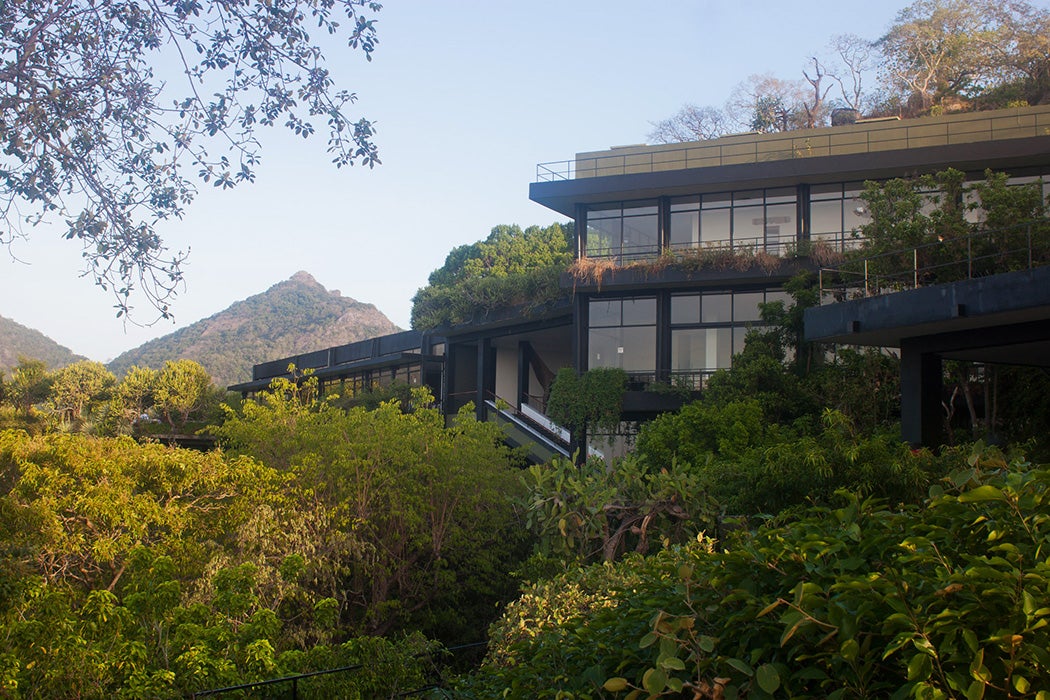The island nation of Sri Lanka and the practice of its most iconic architect, Geoffrey Bawa, are inextricably linked. They both began seventy-five years ago, when Sri Lanka attained independence from its British colonizers and Bawa returned to his newly independent homeland from England. His first and most personal project in 1948 was to build a landscape garden in an abandoned rubber plantation in Lunuganga, near Bentota. Thus began Bawa’s “serendipitous” creative journey into design and architecture.
In a 1998 paper published by the Architectural Association School of Architecture to mark the fiftieth year of the country’s independence and Bawa’s practice, writer David Robson and architect Channa Daswatte delve into his particular brand of architecture. “The two anniversaries are not entirely unconnected,” they write.
In making the transition from restless traveller and reluctant lawyer to builder and gardener, Bawa was setting out on the serendipitous journey which would lead him to become independent Sri Lanka’s most prolific and influential architect.
Twenty-five years on, this shining legacy hasn’t dimmed. In 2019, the Geoffrey Bawa Trust, established to manage and preserve his estate for posterity, marked the centenary of his birth with a project called “Bawa 100.” Its last leg was to be an international traveling archival exhibit of documents related to his work including maps, drawings, letters, photos, and video footage. Despite initially being affected by COVID-19, it began its international sojourn in India this year and will travel to other countries soon.
Bawa was born in 1919 to a barrister and was given a Europeanized upbringing. He moved to England in 1938 to pursue his education and later to join his father’s profession. Disillusioned with his choice, however, he decided to abandon his legal practice once his parents passed away. He began traveling the world and unknowingly formed a design sensibility that would later define his architectural work.
While creating Lunuganga in 1948, he became aware of his “lack of technical knowledge.” A cousin told him to train to be an architect so “you can do what you like doing best with other people’s money.” Robson and Daswatte assert that this philosophy underscored his approach throughout his life. “Bawa designs each building as if it were for himself: he empathizes with his clients and is reluctant to build for people with whom he can’t identify,” they write.
His interesting and widespread practice encompassed some of the most famous buildings in Sri Lanka including the new Parliament and the University of Ruhunu, as well as residential buildings, hotels, offices, and more. In keeping with the system of the time, he didn’t rely on multitudes of drawings, instead breathing life into the design almost instinctively as work progressed. The authors recall that on the building site, “he would sit and stare at the emerging design and then discuss detailed and often radical changes with the baasses (craftsmen).”
Weekly Newsletter
Bawa was open to experimentation and improvisation, a skill that held him in good stead when certain imported building materials weren’t easily available in the country during the 1960s. “Modern fixtures and fittings simply didn’t exist,” write the authors.
[I]t was necessary to work closely with the baasses in order to produce home-made substitutes… This led to a growing interest in the possibilities offered by traditional methods of construction and craftsmanship.
By being rooted in local sensibilities, Bawa earned many labels including “tropical modernist, romantic, vernacularist and regionalist.” Yet he refused to be boxed in, shying away from defining his practice or discussing his methods. In his own words:
When one delights as much as I do in planning a building and having it built, I find it impossible to describe the exact steps in an analytical or dogmatic way. […] I have a very strong conviction that it is impossible to explain architecture in words—I have always enjoyed seeing buildings but seldom enjoyed reading explanations about them—as I feel, with others, that architecture cannot be totally explained but must be experienced.
Nevertheless, Robson and Daswatte attempt to define his multifaceted work by placing him firmly in the context of contemporary Sri Lanka. Detailing six of his key works over five decades of his practice, they conclude that his architecture is “a subtle blend of modern and traditional, of East and West, of formal and picturesque.” This is best seen through the fact that he draws on his “country’s colourful history to create an architecture which is fitting to its place,” but he also scours “the world for ideas with which to inform an architecture which is of its age.”







